Thistles are flowering plants in the Asteraceae family with sharp, prickly leaves. Some species (especially those in dryer areas) also have spines or prickles on their stems and flowers. This is a unique adaptation that protects thistle plants from hungry, plant-eating animals. Many thistle plants look alike, which makes them difficult to differentiate. But don’t worry — we’ve compiled some tips and tricks for identifying at least 15 amazing thistle plants!
Canada Thistle or Creeping Thistle (Cirsium arvense)

Occasionally, creeping thistle plants may produce white flowers.
©Thorsten Schier/Shutterstock.com
The creeping thistle (or Canada thistle) has an underground network of roots that spread like wildfire. In addition, it is a tenacious plant that can live for years. In many areas, it is considered an invasive species. Creeping thistles have spiny, jagged leaves with tiny spikes. In the summer, they produce clusters of rosy-purple, puffy flowers.
Field Thistle (Cirsium discolor)
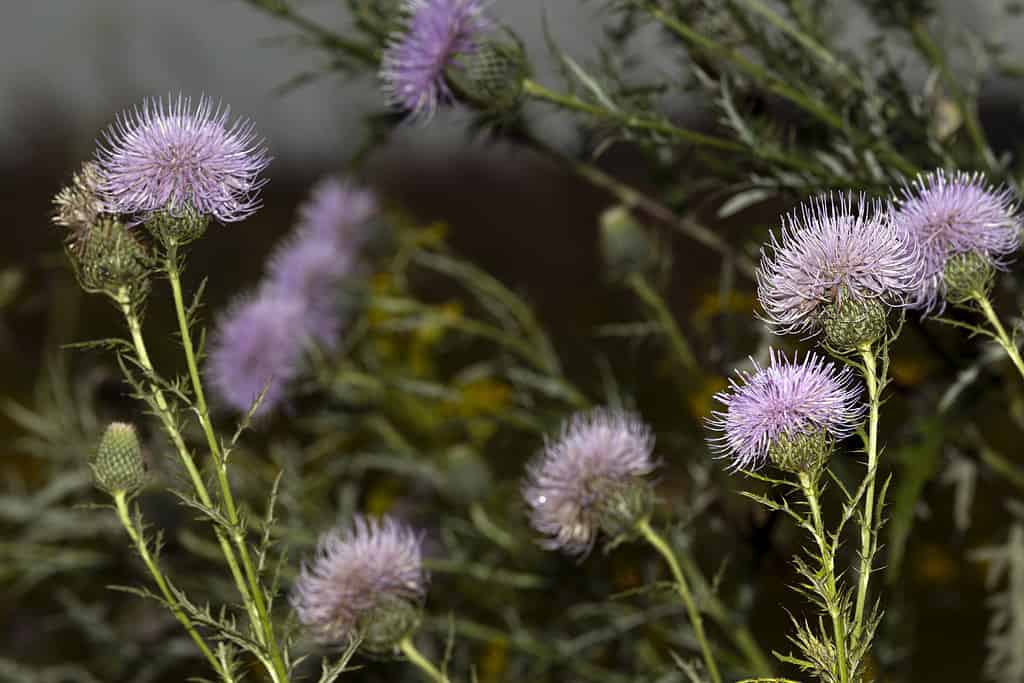
Field thistles bloom from June to October.
©Chimperil59/iStock via Getty Images
Native to North America, the field thistle grows up to 7 feet tall with spiky leaves and hairy, upright stems. Its lovely purplish-pink flowers are favorites of pollinators, especially native butterflies. It can be tricky to differentiate between the field thistle and the much more aggressive bull thistle. However, field thistles have white underneath their leaves, whereas bull thistles do not.
Bull Thistle or Spear Thistle (Cirsium vulgare)

Bull thistle flowers are about 1 to 2 inches in diameter.
©Yavdat/Shutterstock.com
The bull thistle (or spear thistle) is native to Europe, western Asia, and Africa. It also naturalized in North America and Australia. However, in many areas, it is considered an invasive weed because it is a very aggressive grower. Bull thistle is also one of the top plants for nectar production, which is great for pollinators like bees and butterflies. It grows up to 5 feet tall and has pink or purple flowers and spiny leaves with spear-shaped lobes.
Scottish Thistle (Onopordum acanthium)

The thistle is the national flower of Scotland.
©PhilippeGerbet / CC BY-SA 4.0, via Wikimedia Commons - License
Scottish thistle plants can grow up to 12 feet tall with spiky leaves as large as 3 feet long! Their leaves also tend to have a blue-gray appearance because of the very fine, wooly hairs on them. Mature plants may have more than 100 purplish-pink flower heads, each about 1 inch in diameter. These spiky flowers stand straight up like proud, prickly crowns rather than drooping down like many other thistle species. In addition, the Scottish thistle has tiny wing-like structures growing along its stem.
Milk Thistle (Silybum marianum)
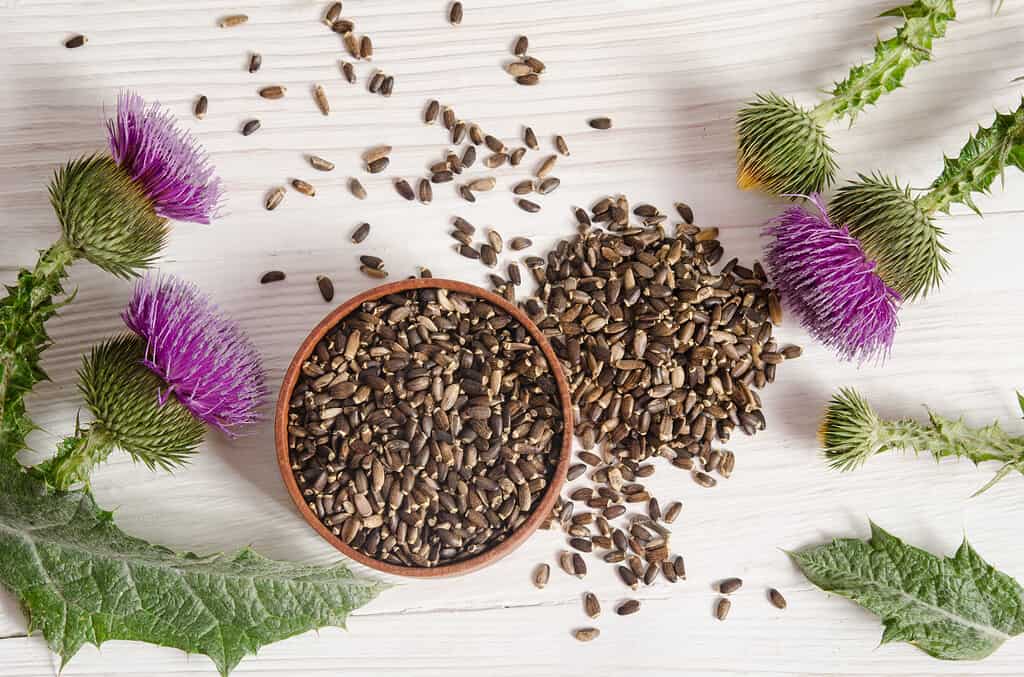
The silymarin in milk thistle seeds may have healing abilities when extracted properly.
©white_caty/iStock via Getty Images
The milk thistle grows all around the world, reaching between 4 to nearly 7 feet tall. It has a cone-shaped body with grooved stems, often with fuzzy areas. The plant’s long, thin leaves are shiny and green with spiky edges. They also have white veins that look like streaks of milk, which is why they are called “milk” thistles. Milk thistle flowers are purple and fluffy like pompoms, with green spikes surrounding them.
Yellow Thistle (Cirsium horridulum)
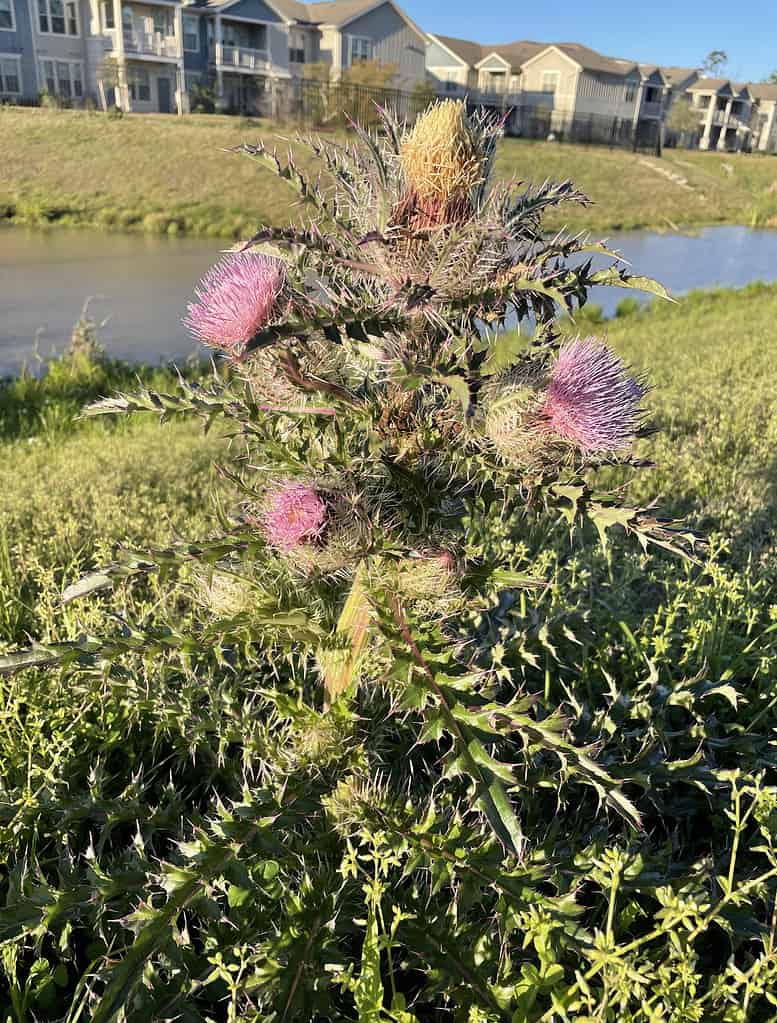
The yellow thistle is also called the purple thistle or the bristle thistle.
©Bladner32 / CC BY-SA 4.0, via Wikimedia Commons - License
Native to North America, yellow thistles grow up to 8 feet tall with 16-inch-long leaves. They are incredibly protected, with thick, sharp spines along the edges of the leaves and sharp spines around the flowers. Although they are called “yellow” thistles, flowers can be yellow, white, pink, red, or purple. Yellow thistles are great for pollinators and serve as hosts for little metalmark and painted lady butterfly caterpillars.
Pasture Thistle (Cirsium pumilum)
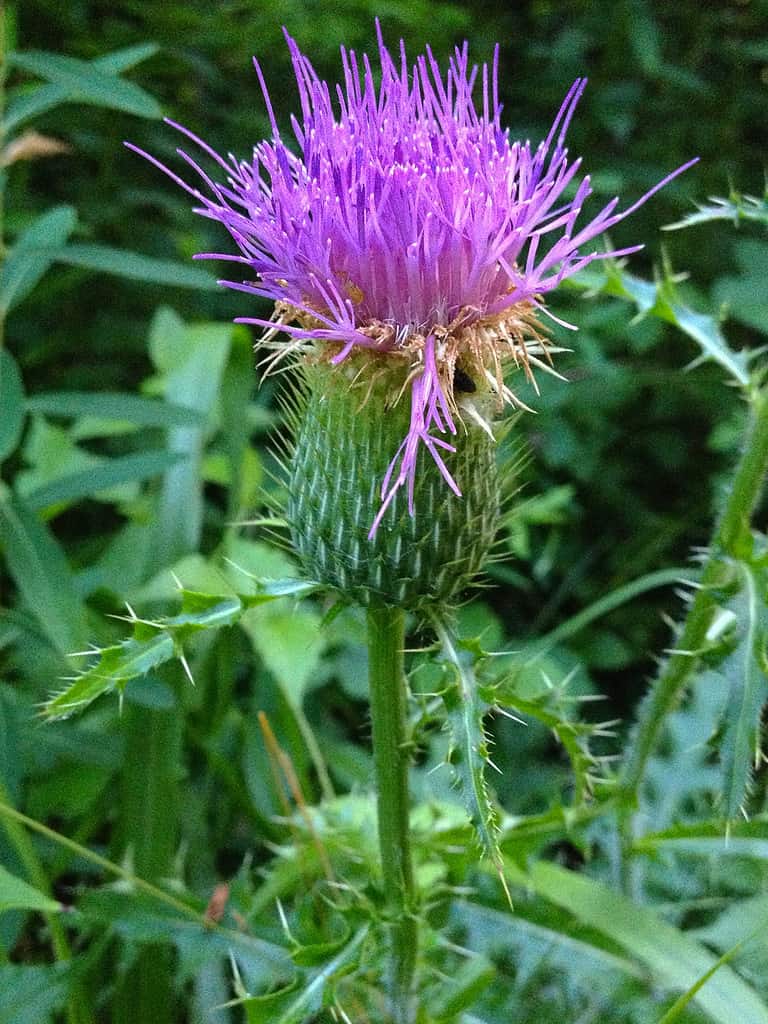
Pasture thistles are usually easier to control than other species.
©Fritz Flohr Reynolds / CC BY-SA 2.0, via Wikimedia Commons - License
Growing in the United States and the Canadian province of Ontario, the pasture thistle stands 1 to 3 feet tall with very fragrant disc flowers. They can be purple, white, or pink, and are very attractive to bees, birds, and butterflies. Pasture thistles have prickly leaves, but fewer spines than some other species. The underside of the leaves is white and densely wooly, and the edges have short and dense spines.
Wavyleaf Thistle (Cirsium undulatum)

Wavyleaf thistles are also called gray thistles.
©JW Stockert / Public domain, via Wikimedia Commons - License
Native to North America, the wavyleaf thistle grows up to 7 feet tall. It may grow one main stem or branch out like a bush. Its leaves are covered in tiny hairs that make them appear a white or grayish color. The leaves also have wavy edges and are deeply cut into spiky lobes. Wavyleaf thistle flowers cluster in pink, lavender, or white bowl-shaped blooms.
Dwarf or Meadow Thistle (Cirsium scariosum)
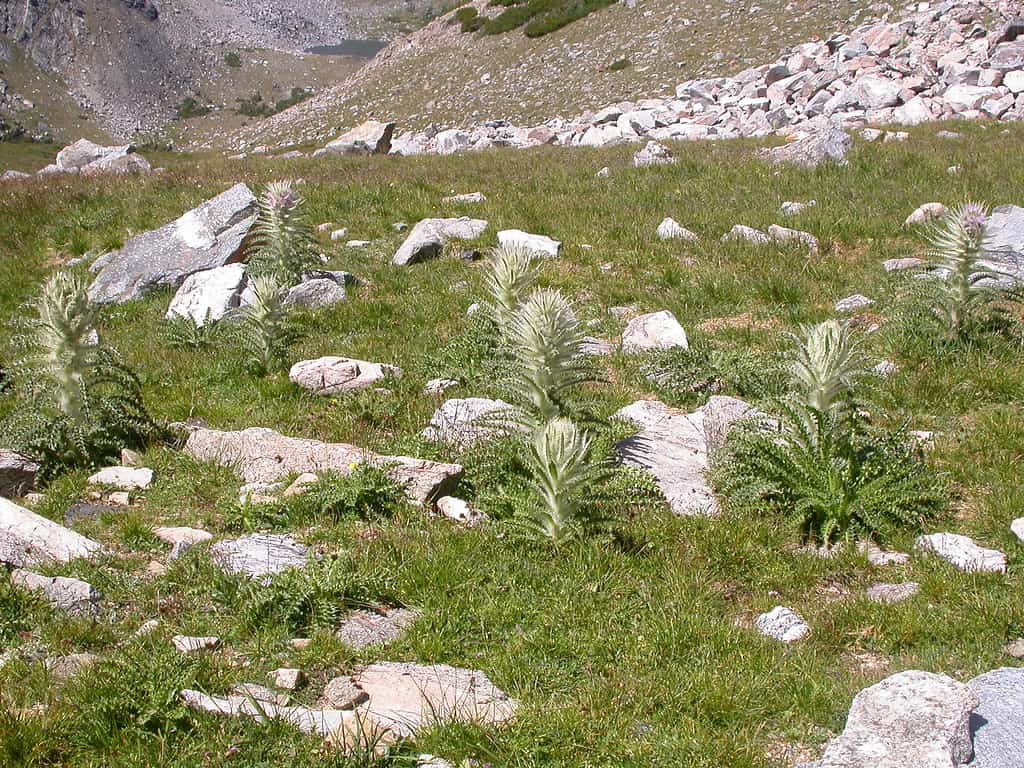
The meadow thistle has a distinctly different appearance depending on where it grows.
©Matt Lavin from Bozeman, Montana, USA / CC BY-SA 2.0, via Wikimedia Commons - License
The dwarf thistle (or meadow thistle) is native to many habitats in North America. It is very adaptive and can grow into various shapes depending on where it is located. Some thistles grow flat and low with a bunch of flowers in the middle, while others can grow up to 7 feet tall. No matter what shape the plant takes, however, its leaves have sharp spiky lobes. They also produce clusters of white or purple flower heads that look like colorful spiky balls.
Melancholy Thistle (Cirsium heterophyllum)
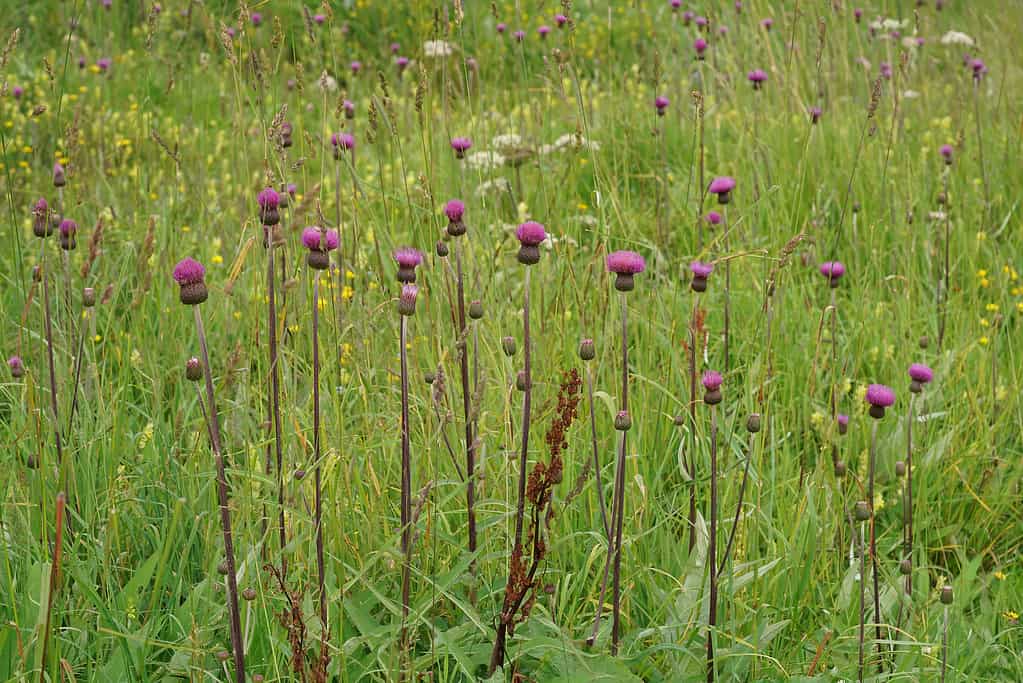
Historically, physicians thought melancholy thistles could help treat “melancholia” (depression).
©Wirestock/iStock via Getty Images
Melancholy thistles grow in the northern regions of the United Kingdom. These tall thistle plants have solitary flower heads surrounded by purple-tinged bracts (leaf-like structures). In addition, unlike most other thistle species, melancholy thistles don’t have any spines!
Musk Thistle (Carduus nutans)
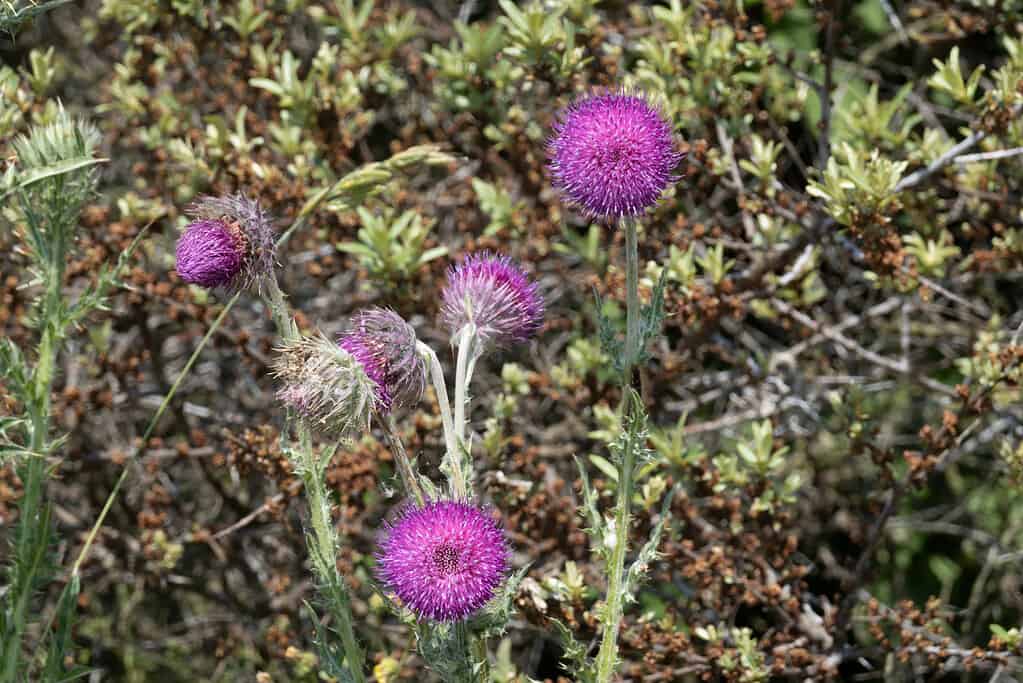
A single flower head of the musk thistle can produce as many as 1,200 seeds.
©TasfotoNL/iStock via Getty Images
Growing from 1 to 7 feet high, the musk thistle produces purple flowers that droop at a 90-degree angle when mature. Because of this, many people call it the “nodding thistle”. Musk thistles may have one or several branching stems covered with spiny wings and dark green leaves. The leaves have light green or silver edges and sharp spines.
Globe Thistle (Echinops)

Although most globe thistles are blue, a few species have white flowers.
©Alex Manders/Shutterstock.com
There are at least 120 species of globe thistles in the Echinops genus. This name comes from a Greek word, echinos, which means “hedgehog” or “sea urchin”. It refers to the plant’s uniquely rounded flower heads. Globe thistles have beautifully blue, sphere-shaped blossoms that look like little golf balls.
Carline Thistle (Carlina vulgaris)
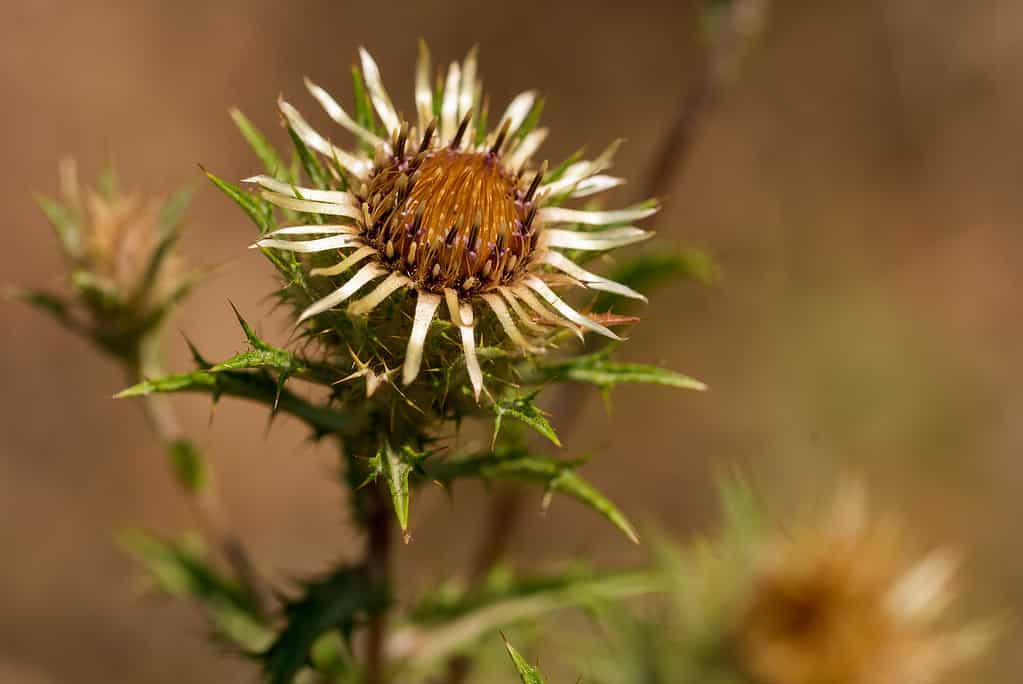
Flowers of the carline thistle typically bloom from July through September.
©Irina Chayko/iStock via Getty Images
Unlike many of the other thistle species, the carline thistle has brown and gold flower heads. They look very similar to other thistle species that have already gone to seed, or even a dying daisy. Despite this appearance, however, pollinators like butterflies and honeybees love them! Carline thistles have long oval-shaped leaves that are wavy and spiny. They grow in chalk or limestone with grasslands or dunes.
Edible Thistle (Cirsium edule)

These plants get their name from their edible roots and young shoots.
©Walter Siegmund / CC BY-SA 3.0, via Wikimedia Commons - License
Edible thistle plants are native to northwestern regions of North America and grow between 3 and 7 feet tall. Their leaves are long, skinny, and have sharp points. Sometimes they’re also lobed or jagged. Young plants are covered in soft fur, but as they mature, all that remains is a spiky line running down the underside of the leaves. Edible thistle flowers are in clusters of pink, disc-shaped blooms that hang down like tiny lanterns when they are young.
Slender Thistle (Carduus tenuiflorus)
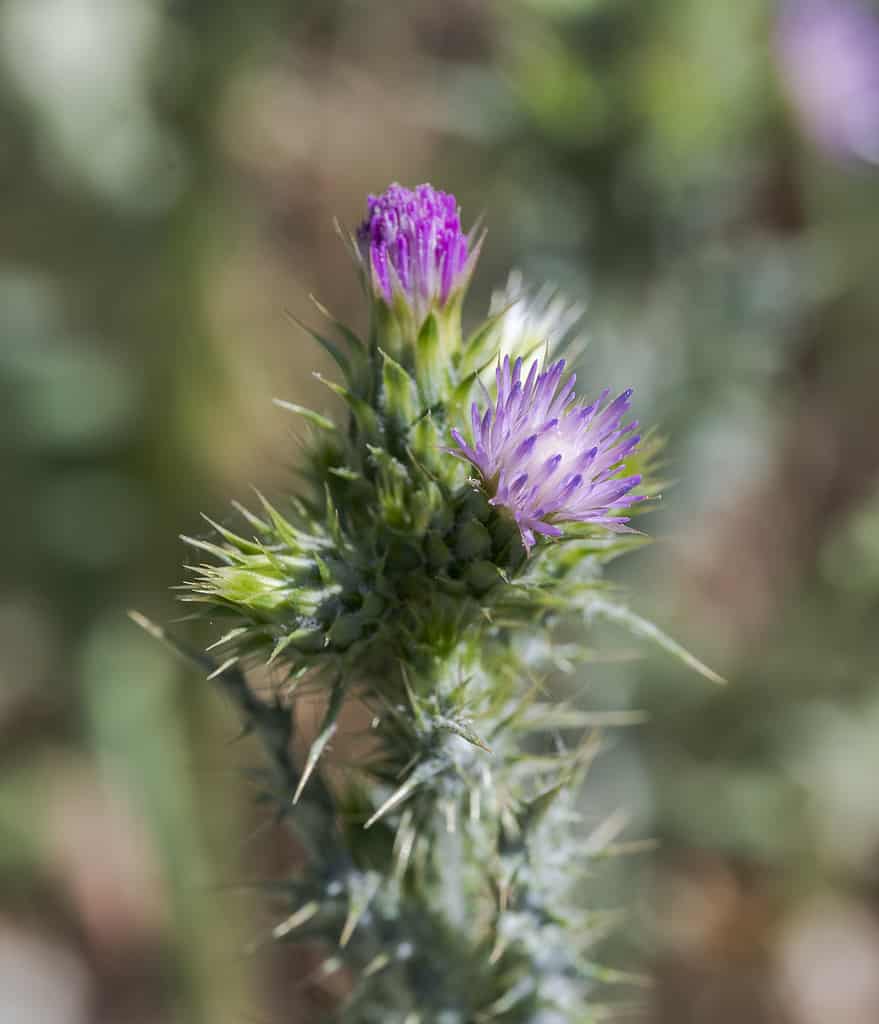
Slender thistles are toxic due to high levels of nitrate.
©IHervas/iStock via Getty Images
Growing upwards of 6.5 feet tall, slender thistle plants have stems covered in long sharp spines. Their dull, olive-green leaves also look wrinkled or creased. Slender thistles are native to Europe and North Africa, but they have been introduced in many other parts of the world as well. The pink or bright purple flower heads are packed closely together and covered in sharp spines.
The photo featured at the top of this post is © Yavdat/Shutterstock.com
Thank you for reading! Have some feedback for us? Contact the AZ Animals editorial team.






